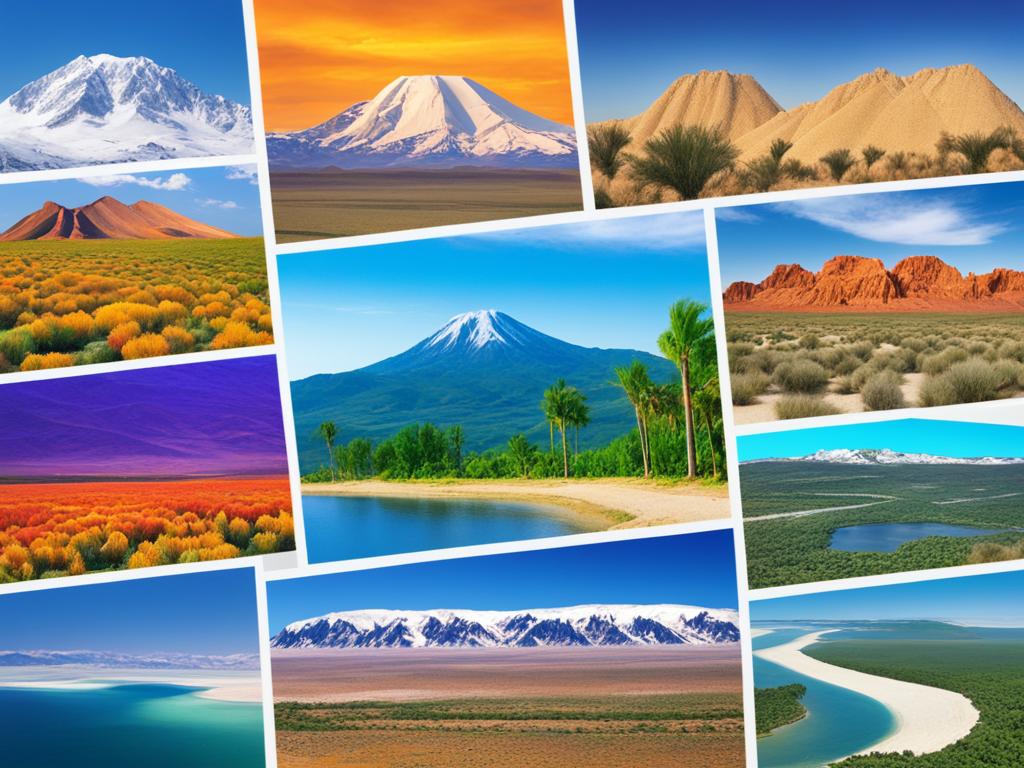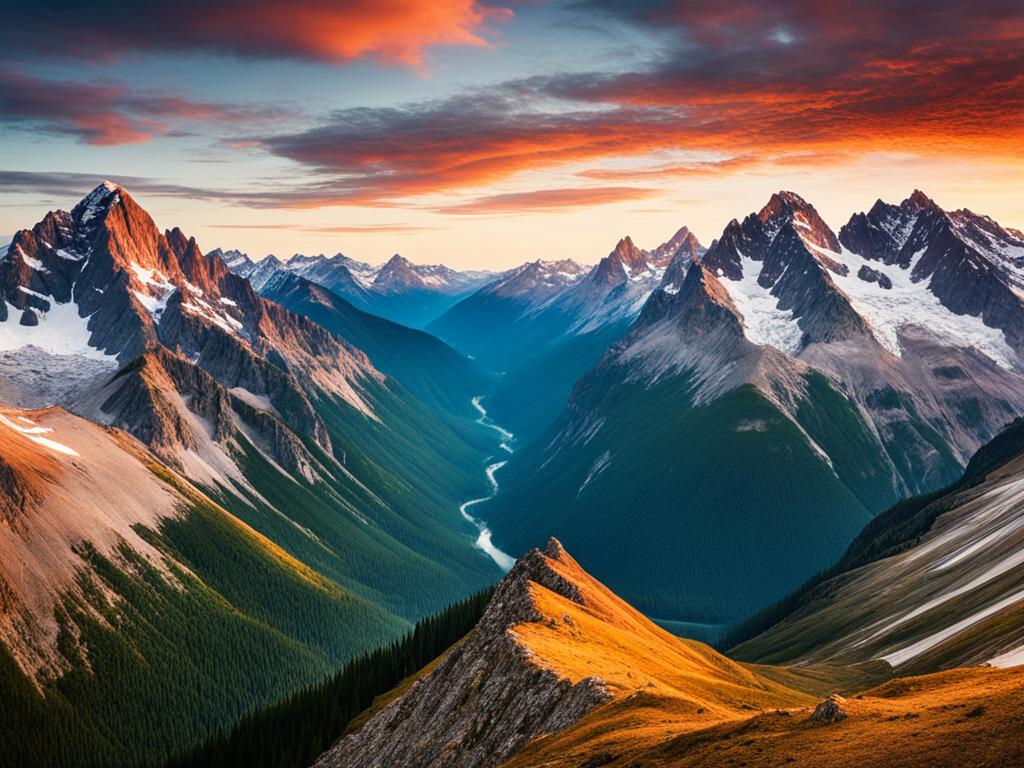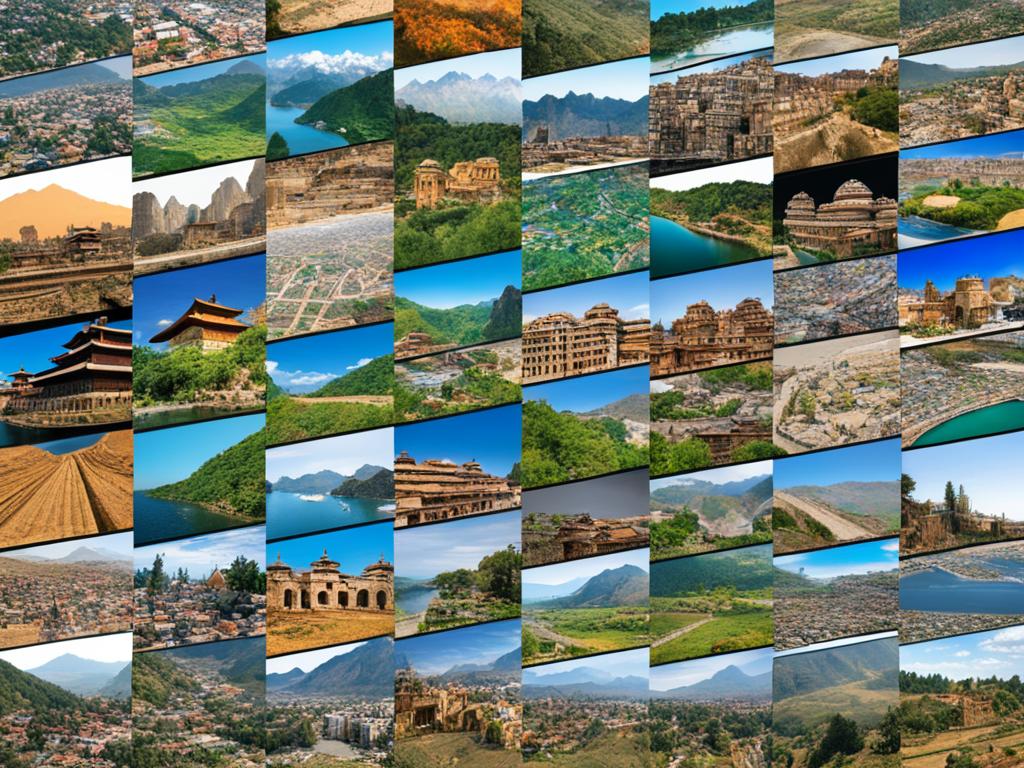The world offers a vast range of regions that spark our curiosity and wonder. From the grand Himalayas to the wide African savannas, continents, landscapes, and landforms demonstrate Earth’s rich variety. We will take a close look at the unique qualities of major regions. These areas influence cultural diversity, demographics, urbanization, and environmental challenges globally.
Key Takeaways
- The continents of Earth cover approximately 148 million square kilometers (57 million square miles) of land, with the ocean covering more than double this area.
- Asia is the largest continent, with the longest series of coastlines, while the average elevation of the continents is around 838 meters (2,750 feet) above sea level.
- North America extends from the Aleutian Islands to the Isthmus of Panama, featuring young mountain ranges in the West and older ranges along the East Coast.
- The continents began forming nearly four billion years ago, with the supercontinent Pangaea breaking apart around 200 million years ago to give rise to the continents we know today.
- Kennesaw State University’s “Year Of” program has been introducing students to world cultures for the past 40 years, fostering intercultural competencies and global engagement.
Introduction to the Continents
Earth’s surface is divided into seven major continents. These are Asia, Africa, North America, South America, Antarctica, Europe, and Australia. They together cover about 148 million square kilometers.
Geographers count islands as part of their continents. For example, Japan is part of Asia. Greenland is part of North America.
Defining a Continent
Continents are defined by their continental shelves. They are gently sloping areas in the ocean from the coastline. The way we see continents can change, depending on the criteria we use.
Formation of Continents
Over billions of years, the Earth’s crust and tectonic plates formed the continents. These plates moved and changed the Earth’s surface. We call this process plate tectonics.
Tectonic Plate Movements
Heat deep within the Earth drives the movement of tectonic plates. This makes continents shift positions over millions of years. About 240 million years ago, these continents were together in one landmass we know as Pangaea. Over time, they broke apart and became the continents we see today.
Exploring the Geography of Asia, Africa, the Americas, Europe, and Oceania
The first source paints a great picture. It shows us the key features of major continents. Asia is huge and has the most shoreline. North America sprawls from the Aleutian Islands to Panama. It has a mix of terrains, from young mountains like the Rockies to the East’s older ones like the Appalachians, as well as wide open plains.
South America’s standout feature is the vast Andes mountain range by its west coast. Europe and Asia make up a big landmass, Eurasia. This land is divided by an imaginary line. This shows how our planet’s landscapes change and grow over time.
| Continent | Key Geographic Features |
|---|---|
| Asia | Largest continent, longest coastlines |
| North America | Extends from Aleutian Islands to Panama, young mountain ranges in the West, older ranges in the East, vast interior plains |
| South America | Dominated by the Andes mountain range along the western edge |
| Europe and Asia | Together form the single landmass of Eurasia, with an imaginary line separating the two culturally distinct regions |
The varied landscapes of these continents show how rich and unique our planet is. They make us want to explore more and learn more.

Geographical Regions and Regionalization
Regions are made around areas with special features. These include things like the land, culture, money, or politics. Types of regions go from huge areas like the Indo-Pacific to small places like a valley. Things such as how people speak, their religion, and who they are help make a region feel unique.
Defining Geographical Regions
In the 19th century, regionalization started making big changes. The first wave was about Europe signing early agreements and forming unions. After World War I, it found new life with groups like the Commonwealth. This pattern has stayed part of the world’s way of organizing, working well with global events. With time, these waves have formed the regional landscape we see now.
Waves of Regionalization
In the 19th century, a special kind of change started happening. Europe began to make deals and work together through unions. After World War I, these efforts grew and spread, not just in Europe but also using groups like the Commonwealth. This way of creating regions has kept going over time, working hand in hand with global events. As a result, regions have changed and grown to what we know today.
Physical Geography of the Continents
Mountain Ranges
The first source talks about the types of mountain ranges we find on continents. Young ranges like the Rockies and Andes are near coasts. Then, we have older ranges like the Appalachians in the middle of continents. The movement of tectonic plates is what builds these mountains.
Plains and Plateaus
The first source also mentions vast plains and large plateaus on continents. North America’s interior plains got fertile soil from glaciers in the recent Ice Age. Plateaus are flat, high areas that are found all over continents as well.
River Systems
Rivers are an essential part of all continents’ landscapes, says the first source. They help shape the land, moving soil and carving paths for settlements. Rivers also connect many places, making them important for people and nature.

Movement and Migration
Human migration over centuries has shaped different regions. People have moved due to conflict, lack of resources, or the need for better jobs. This has spread populations and cultures worldwide.
This mixing of people has led to the diverse cultural identities we see today.
Historical Human Migrations
The exchange of goods, services, and ideas through trade and transport has also been key. Networks like maritime routes and communication links have united distant lands. They’ve allowed for the flow of goods, technology, and culture, changing regions over time.
Trade and Transportation Networks
Oceania, home to 14 countries, saw 41.8 million people living there in 2020. Migrants make up 22% of its population. Australia, New Zealand, Palau, and Nauru have the most migrants.
Over half of the 2 million migrants from Oceania move within the region. American Samoa, New Caledonia, and Guam are popular destinations.
In South-eastern Asia, there were 669 million people in 2020. About 23.6 million from this area live outside their home countries. The Philippines has over six million emigrants, the most in the region.
Human Systems and Settlements
Regions are shaped by many things, like their physical features and the people who live there. The way we use resources, socialize, and govern ourselves impacts the region’s feel. This makes each place both different and interesting in its way.
Economic Systems
How we make money and use resources is key to what a region looks like and how it grows. Whether through farming, making things, or providing services, each region’s money-making ways guide its future. This includes the jobs available, the products traded, and how money is used.
Social and Cultural Systems
Our language, beliefs, and background shape the places we live. They influence everything from how we understand our area to how we deal with differences. These traits can bring people together but also lead to tensions as diverse groups navigate life together.
Political Systems
Who holds power and makes decisions affects the regions we live in, from tiny towns to whole countries. This control is built on a history of many influences, like colonization and global politics. It’s these big and small political actions that stitch together the complex story of our regions.

Human-Environment Interactions
Environmental Modifications
Humans have changed the look of continents through a range of activities. This includes creating mountains, changing weather patterns, and the movement of earth materials. These changes have significantly impacted the natural world. They’ve altered landscapes and ecosystems to better fit human needs and wants. These changes happen all around the world.
Adaptation to Environmental Changes
Humans have learned to live with changes in the earth’s climate. They’ve faced glacial movements, sea level changes, and other climate shifts. This ability to adapt is crucial. It has allowed human society to not just survive but thrive in different parts of the planet.
Place and Regional Identity
Oceania’s different landscapes give each area its unique feel. From the rough lands of Melanesia to the tiny islands in Micronesia, geography shapes everything. It affects how the local economy grows, the people get around, and what cultural traditions people follow. The way land and water are arranged in Oceania has a big impact. This includes how people work together, share a history, speak languages, and have similar backgrounds.
Physical Characteristics of Regions
Every part of Oceania has a special look, from Polynesia’s islands formed by volcanoes to the South Pacific’s beautiful coral reefs. This variety plays a big part in what Oceania does commercially, how people travel, and where they live. The natural riches here, like the large sea zones, are very important too. They guide how Oceania and its people use the ocean around them.
Cultural Identities and Diversity
Oceania’s mix of cultures is also what makes it stand out. Hundreds of native groups live here, each with their own culture, language, and life. This mix is celebrated in things like the Pacific Arts Festival. This festival brings people from all over Oceania to share their culture. It’s a living proof of Oceania’s diverse and rich culture. This diversity shows how Oceania has many different stories and ways of life. But, at the same time, there are things that bring them together.
Source Links
- https://education.nationalgeographic.org/resource/Continent/
- https://www.kennesaw.edu/global-education/year-of/index.php
- https://open.umn.edu/opentextbooks/textbooks/335
- https://en.wikipedia.org/wiki/Continent
- https://education.nationalgeographic.org/resource/north-america-physical-geography
- https://www.classvr.com/vr-ar-resources/geography-vr-teaching-resources/
- https://pressbooks.pub/worldgeo/chapter/east-and-southeast-asia/
- https://pressbooks.pub/worldgeo/chapter/chapter-1/
- https://www.cambridge.org/core/books/regional-politics-in-oceania/oceania-and-the-study-of-regions/79DBEBE6E4E909F88C76F5AEF00B047C
- https://www.migrationdataportal.org/regional-data-overview/oceania
- https://www.migrationdataportal.org/regional-data-overview/south-eastern-asia
- https://education.nationalgeographic.org/resource/oceania-human-geography/
- https://education.nationalgeographic.org/resource/north-america-human-geography
- http://mrshermanshistory.weebly.com/introduction-to-geography.html


